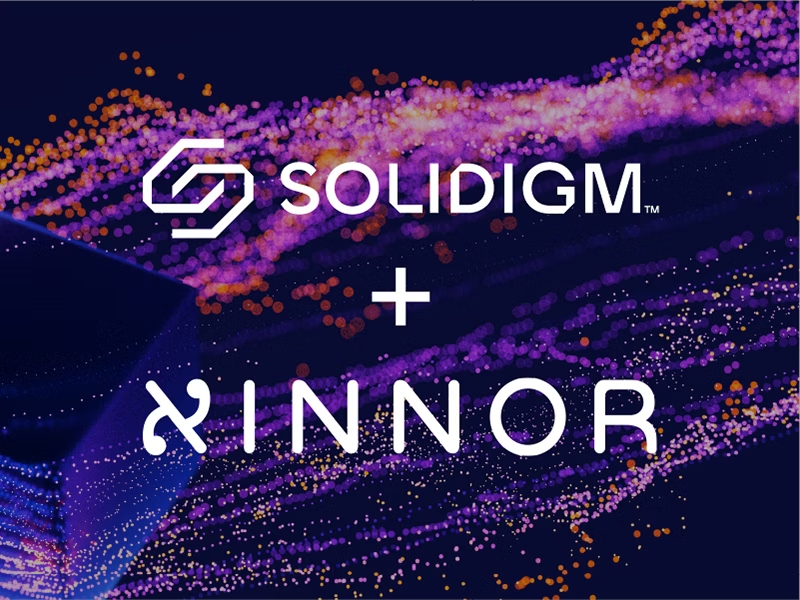Revolutionizing Edge AI & Seismic Data Processing With Immersion-Cooled Storage


The convergence of artificial intelligence (AI), high-performance computing (HPC), and edge deployment demands innovative approaches to data processing infrastructure. DUG Technology, a leader in HPC and immersion cooling solutions, has created DUG Nomad, a groundbreaking data center in a shipping container. When combined with Hypertec servers and Solidigm™ NVMe SSDs, DUG Nomad brings unprecedented computational power directly to edge deployment.
This collaboration showcases how immersion cooling technology, purpose-built servers, and high-performance storage can transform AI and HPC at the edge.
The challenge: Bringing data centers to the edge
Traditional data processing workflows require transporting massive volumes of raw data from remote collection sites to centralized data centers for analysis, a process fraught with significant challenges.
Limits in network bandwidth restrict the volume of data that can be transmitted
Data processing latency delays critical decision-making
Moving all raw data across networks is cost prohibitive
Consider the challenges of acquiring, processing, and transmitting data in the Saudi Arabian desert, one of the world’s most remote and unforgiving environments. Innovative edge computing solutions revolutionize data acquisition at isolated and mobile data collection sites, enabling hyper efficient collection of seismic data.
The ability to run high-level, compute-intensive algorithms on live data feeds makes real-time analysis possible. Adding high-density storage solutions enables continuous, uninterrupted operations, maximizing efficiency and accelerating time to insight.
The solution: DUG Nomad mobile data center
DUG Nomad, a containerized, immersion-cooled data center, can be deployed anywhere in the world. This mobile solution brings high-performance computing capabilities directly to data collection sites, enabling real-time processing and analysis at the edge.
The system is available in multiple configurations, including 10-foot, 20-foot, and 40-foot container sizes, with the 10-foot model providing 26 usable rack units of computing space. The containers are designed for helicopter transport with integrated lifting points, making them deployable in locations that would be impossible to reach with traditional computing infrastructure. DUG Nomad can operate practically anywhere due to its -40°C to +50°C range and with its weatherproof and sealed design, requiring only a power connection for complete self-sufficiency.
 The DUG Nomad containerized, immersion-cooled data center that can be deployed anywhere in the world
The DUG Nomad containerized, immersion-cooled data center that can be deployed anywhere in the world
Perhaps most remarkably, the entire system can be deployed and operational in under two hours, providing immediate access to data center-level computing and storage capabilities in remote locations.
The technical innovation: Hypertec immersion-born server design purpose-built for edge deployment
Hypertec’s contribution represents a fundamental shift from “immersion-ready” to “immersion-born” server design. Rather than adapting air-cooled servers for liquid environments, Hypertec designs servers specifically for immersion cooling from the ground up, resulting in superior performance, reliability, and efficiency.
The immersion-born design philosophy manifests in optimized component placement throughout the server chassis. GPUs are positioned at the bottom of tanks where temperatures are coolest, while power supplies and other heat-generating components are strategically located for maximum efficiency. Specialized materials include custom heat sinks designed for specific cooling fluid viscosities, indium foil thermal interfaces that don’t degrade in liquid environments, and immersion-certified cables and connectors. Hypertec TRIDENT immersion-born servers’ internal chassis and layout are engineered to guide coolant flow smoothly and minimize hotspots, ensuring even thermal distribution. Fin pitch in the custom heat sinks is optimized for the higher viscosity of dielectric fluids, improving circulation and heat transfer efficiency. All components are rigorously tested for long-term immersion performance, including Highly Accelerated Stress Tests (HAST), fluid aging tests, and compatibility testing to resist swelling, corrosion, and degradation. Thermal interface materials (TIMs) are selected for their durability and conductivity in immersion environments, supporting consistent, long-term system reliability.
The density achievements are remarkable. The 10-foot DUG Nomad model, which provides 26 usable rack units of traditional computing space, can accommodate specialized immersion cooling tanks of various heights. A single 26RU tank is capable of supporting in excess of 50 modern CPU servers utilizing AMD EPYC or Intel Xeon processors, or over 100 H200 GPUs using an extremely dense configuration of 4 GPUs in a 1RU chassis.
Reliability metrics demonstrate zero component failures reported in over four years of operation in some deployments, with stable operating temperatures eliminating thermal cycling stress that degrades components in traditional air-cooled systems. DUG has servers (which have a typical lifespan of five years), that are still running smoothly nine years after first being immersed.
The storage: Solidigm high-performance SSDs at the edge
Solidigm NVMe SSD solutions provide the high-performance storage foundation optimal for edge AI and seismic processing workloads. The compact form factors and exceptional performance characteristics make them ideally suited for the space-constrained, performance-critical environment of the DUG Nomad system.

Solidigm has worked with DUG and Hypertec to validate this proof of concept. The current storage implementation utilizes 16 Solidigm E1.S SSDs within a single 1U storage server, providing approximately 320TB of total capacity per storage node. The scalability potential extends significantly, with E1.L form factor support enabling up to 1.9 petabytes (PB) of storage capacity in a single 1U server.
High IOPS performance supports concurrent AI inferencing workloads, while low latency enables real-time decision making. Storing more data at the edge greatly reduces the need to transmit raw data to remote processing centers, allowing the intelligent data filtering system to reduce bandwidth requirements significantly.
Use cases and applications
The combination of HPC, storage, and cooling enables sophisticated AI and compute-intense applications at the edge. Use cases include computer vision processing for remote monitoring, predictive analytics using real-time sensor data, autonomous systems requiring low-latency decision making, and scientific modeling and simulation directly at edge data collection sites.
For applications that involve sensitive or confidential information, edge computing delivers private, in-facility or in-country capabilities.
Business impact and ROI
Operational efficiency
Real-time edge processing greatly reduces raw data transmission requirements, creating significant reductions in cloud storage and bandwidth costs while accelerating time-to-insight for geological surveys and exploration activities.
Power efficiency
The immersion-born server design delivers meaningful power savings compared to traditional air-cooled solutions. Research published in Energy Informatics shows that immersion-cooled data centers consume up to 50% less energy than their air-cooled counterparts. DUG reduced its overall power consumption by 51% when it moved to immersion cooled data center design. Eliminating server fans alone reduced the total power consumption by up to 25%. DUG achieves power usage effectiveness (PUE) ratings as low as 1.02 compared to industry averages of 1.55+. The consistent low operating temperatures enable processors to maintain peak efficiency curves while avoiding thermal throttling that degrades performance and increases power draw in air-cooled systems.
Infrastructure optimization
Using a single mobile unit to replace building multiple fixed installations maximizes equipment utilization across projects. Immersion cooling dramatically improves component reliability, reducing replacement and maintenance costs while providing consistent performance in challenging environments.
Strategic advantages
Enhanced data analysis capabilities, reduced equipment failure risks, and increased operational flexibility enable organizations to pursue opportunities not viable with traditional computing infrastructure.
Future roadmap and scalability
Technology evolution will continue through storage advancement including migration to much higher-capacity Solidigm SSDs, integration of next-generation PCIe protocols, and potential computational storage technologies. Compute platform growth will incorporate next-generation GPU architectures and specialized AI accelerators in larger container configurations such as the DUG Nomad 40.
Market expansion opportunities extend to remote manufacturing and industrial IoT applications, scientific research in extreme environments, and emergency response scenarios where rapid deployment of computing resources is critical.
Conclusion
The combination of DUG Nomad, Hypertec immersion-born servers, and Solidigm high-performance SSDs represents a paradigm shift in edge computing infrastructure that addresses fundamental challenges by bringing advanced computational capabilities to remote and challenging environments.
Through the combination of several innovative solutions from the various architectural pieces of technology, this solution demonstrates that data center-level performance can be achieved in mobile, self-contained packages that can operate effectively anywhere in the world.
Whether applied to seismic imaging with DUG’s advanced data processing, AI inferencing, or scientific research, this integrated solution provides exceptional capabilities that transform how organizations approach data processing in remote environments.
As edge AI and HPC workloads continue to grow in importance across industries, solutions like DUG Nomad will become increasingly critical for organizations seeking to maximize the value of their data while minimizing the costs and complexity of traditional centralized processing approaches. The demonstrated reliability, performance, and deployment flexibility of this integrated solution establishes a new standard for edge computing infrastructure that will influence the development of future technologies and applications.
Disclaimers
Nothing herein is intended to create any express or implied warranty, including without limitation, the implied warranties of merchantability, fitness for a particular purpose, and non-infringement, or any warranty arising from course of performance, course of dealing, or usage in trade.
The products described in this document may contain design defects or errors known as “sightings,” which may cause the product to deviate from published specifications. Current characterized sightings are available on request.
Solidigm does not control or audit third-party data. You should consult other sources to evaluate accuracy.
Contact your Solidigm representative or your distributor to obtain the latest specifications before placing your product order.
SOLIDIGM and the Solidigm “S” logo are trademarks of SK hynix NAND Product Solutions Corp. (d/b/a Solidigm), registered in the United States, People’s Republic of China, Japan, Singapore, the European Union, the United Kingdom, Mexico, and other countries.


